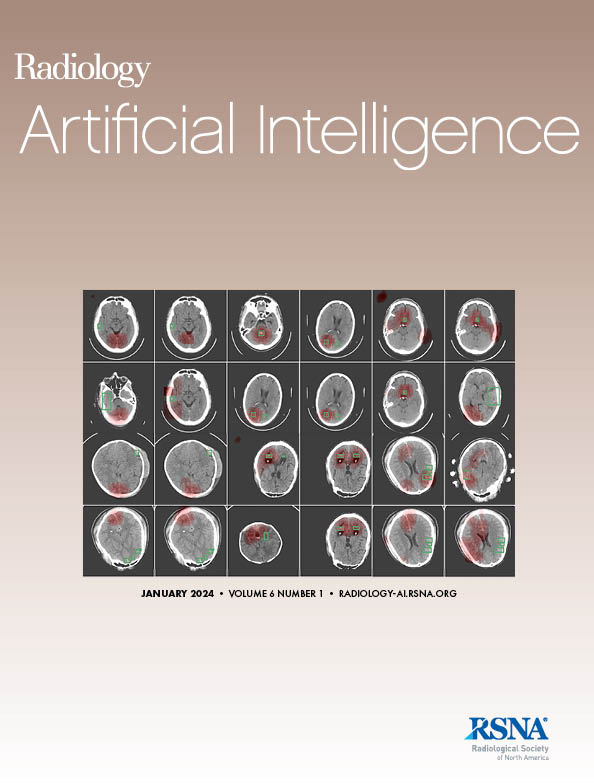下载PDF
{"title":"基于图像和特征空间随机化的深度学习用于腹部CT和MRI多器官分割。","authors":"Yu Shi, Lixia Wang, Touseef Ahmad Qureshi, Zengtian Deng, Yibin Xie, Debiao Li","doi":"10.1148/ryai.240586","DOIUrl":null,"url":null,"abstract":"<p><p>Purpose To develop a deep learning segmentation model that can segment abdominal organs on CT and MRI scans with high accuracy and generalization ability. Materials and Methods In this study, an extended nnU-Net model was trained for abdominal organ segmentation. A domain randomization method in both the image and feature space was developed to improve the generalization ability under cross-site and cross-modality settings on public prostate MRI and abdominal CT and MRI datasets. The prostate MRI dataset contains data from multiple health care institutions, with domain shifts. The abdominal CT and MRI dataset is structured for cross-modality evaluation: training on one modality (eg, MRI) and testing on the other (eg, CT). This domain randomization method was then used to train a segmentation model with enhanced generalization ability on the abdominal multiorgan segmentation challenge dataset to improve abdominal CT and MR multiorgan segmentation, and the model was compared with two commonly used segmentation algorithms (TotalSegmentator and MRSegmentator). Model performance was evaluated using the Dice similarity coefficient (DSC). Results The proposed domain randomization method showed improved generalization ability on the cross-site and cross-modality datasets compared with the state-of-the-art methods. The segmentation model using this method outperformed two other publicly available segmentation models on data from unseen test domains (mean DSC, 0.88 vs 0.79 [<i>P</i> < .001] and 0.88 vs 0.76 [<i>P</i> < .001]). Conclusion The combination of image and feature domain randomizations improved the accuracy and generalization ability of deep learning-based abdominal segmentation on CT and MR images. <b>Keywords:</b> Segmentation, CT, MR Imaging, Neural Networks, MRI, Domain Randomization <i>Supplemental material is available for this article.</i> © RSNA, 2025 See also commentary by Mayfield in this issue.</p>","PeriodicalId":29787,"journal":{"name":"Radiology-Artificial Intelligence","volume":" ","pages":"e240586"},"PeriodicalIF":13.2000,"publicationDate":"2025-07-01","publicationTypes":"Journal Article","fieldsOfStudy":null,"isOpenAccess":false,"openAccessPdf":"https://www.ncbi.nlm.nih.gov/pmc/articles/PMC12476582/pdf/","citationCount":"0","resultStr":"{\"title\":\"Deep Learning with Domain Randomization in Image and Feature Spaces for Abdominal Multiorgan Segmentation on CT and MRI Scans.\",\"authors\":\"Yu Shi, Lixia Wang, Touseef Ahmad Qureshi, Zengtian Deng, Yibin Xie, Debiao Li\",\"doi\":\"10.1148/ryai.240586\",\"DOIUrl\":null,\"url\":null,\"abstract\":\"<p><p>Purpose To develop a deep learning segmentation model that can segment abdominal organs on CT and MRI scans with high accuracy and generalization ability. Materials and Methods In this study, an extended nnU-Net model was trained for abdominal organ segmentation. A domain randomization method in both the image and feature space was developed to improve the generalization ability under cross-site and cross-modality settings on public prostate MRI and abdominal CT and MRI datasets. The prostate MRI dataset contains data from multiple health care institutions, with domain shifts. The abdominal CT and MRI dataset is structured for cross-modality evaluation: training on one modality (eg, MRI) and testing on the other (eg, CT). This domain randomization method was then used to train a segmentation model with enhanced generalization ability on the abdominal multiorgan segmentation challenge dataset to improve abdominal CT and MR multiorgan segmentation, and the model was compared with two commonly used segmentation algorithms (TotalSegmentator and MRSegmentator). Model performance was evaluated using the Dice similarity coefficient (DSC). Results The proposed domain randomization method showed improved generalization ability on the cross-site and cross-modality datasets compared with the state-of-the-art methods. The segmentation model using this method outperformed two other publicly available segmentation models on data from unseen test domains (mean DSC, 0.88 vs 0.79 [<i>P</i> < .001] and 0.88 vs 0.76 [<i>P</i> < .001]). Conclusion The combination of image and feature domain randomizations improved the accuracy and generalization ability of deep learning-based abdominal segmentation on CT and MR images. <b>Keywords:</b> Segmentation, CT, MR Imaging, Neural Networks, MRI, Domain Randomization <i>Supplemental material is available for this article.</i> © RSNA, 2025 See also commentary by Mayfield in this issue.</p>\",\"PeriodicalId\":29787,\"journal\":{\"name\":\"Radiology-Artificial Intelligence\",\"volume\":\" \",\"pages\":\"e240586\"},\"PeriodicalIF\":13.2000,\"publicationDate\":\"2025-07-01\",\"publicationTypes\":\"Journal Article\",\"fieldsOfStudy\":null,\"isOpenAccess\":false,\"openAccessPdf\":\"https://www.ncbi.nlm.nih.gov/pmc/articles/PMC12476582/pdf/\",\"citationCount\":\"0\",\"resultStr\":null,\"platform\":\"Semanticscholar\",\"paperid\":null,\"PeriodicalName\":\"Radiology-Artificial Intelligence\",\"FirstCategoryId\":\"1085\",\"ListUrlMain\":\"https://doi.org/10.1148/ryai.240586\",\"RegionNum\":0,\"RegionCategory\":null,\"ArticlePicture\":[],\"TitleCN\":null,\"AbstractTextCN\":null,\"PMCID\":null,\"EPubDate\":\"\",\"PubModel\":\"\",\"JCR\":\"Q1\",\"JCRName\":\"COMPUTER SCIENCE, ARTIFICIAL INTELLIGENCE\",\"Score\":null,\"Total\":0}","platform":"Semanticscholar","paperid":null,"PeriodicalName":"Radiology-Artificial Intelligence","FirstCategoryId":"1085","ListUrlMain":"https://doi.org/10.1148/ryai.240586","RegionNum":0,"RegionCategory":null,"ArticlePicture":[],"TitleCN":null,"AbstractTextCN":null,"PMCID":null,"EPubDate":"","PubModel":"","JCR":"Q1","JCRName":"COMPUTER SCIENCE, ARTIFICIAL INTELLIGENCE","Score":null,"Total":0}
引用次数: 0
引用
批量引用

 求助内容:
求助内容: 应助结果提醒方式:
应助结果提醒方式:


